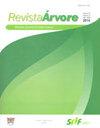半落叶森林片段中树种直径分布的建模
IF 0.8
4区 农林科学
Q4 FORESTRY
引用次数: 0
摘要
模拟天然林的直径分布是了解本地木本物种动态的重要工具,为退化土地的管理和恢复提供决策支持。因此,本文拟合概率密度函数,对三种具有经济价值的树种(如camomansesia xanthocarpa Marl)的直径结构进行评价。O. Berg, Piptadenia gonoacantha (Mart.)参考书籍Macbr。和结核Zeyheria tuberculosis (well .)前总督局在巴西圣保罗州的半落叶季节性森林片段中。数据来自83个10米× 20米的临时地块,系统分布在164公顷的土地上。使用R程序中的fitdistrplus-package对这三个物种进行了对数正态、伽玛和威布尔函数的拟合。采用Kolmogorov-Smirnov依从性检验在5%概率水平上评价拟合。采用赤池的信息准则(AIC)和施瓦茨的贝叶斯信息准则(BIC)选择函数,并对拟合函数进行图形分析。结果表明:三种林分直径结构呈正不对称,呈指数型,呈现连续的自然更新;AIC和BIC统计结果表明,黄杉和结核菌的直径分布均采用log -正态函数,而甘露菌的直径分布则采用Gamma函数。对这三个物种,图形分析表明伽玛函数的拟合效果最好,对估计每直径类的频率密度没有倾向。本文章由计算机程序翻译,如有差异,请以英文原文为准。
MODELING DIAMETER DISTRIBUTION OF TREE SPECIES IN A SEMIDECIDUOUS FOREST FRAGMENT
ABSTRACT Modeling diameter distribution in natural forests is an important tool for understanding the native woody species dynamics, supporting decision-making for degraded lands management and restoration. Therefore, this work aimed to fit probabilistic density functions to evaluate the diameter structure of three tree species with economic interest, such as Campomansesia xanthocarpa Marl. Ex. O. Berg, Piptadenia gonoacantha (Mart.) J.F. Macbr. and Zeyheria tuberculosa (Vell.) Bureau ex Verl., in a Semideciduous Seasonal Forest fragment at São Paulo State, Brazil. The data came from 83 temporary plots of 10 m x 20 m systematically distributed along 164 ha. Log-normal, Gamma, and Weibull functions were fitted to the three species using the fitdistrplus-package in the R program. Kolmogorov-Smirnov's adherence test was used to evaluate the fits at a 5% probability level. The functions were selected employing Akaike's Information Criterion (AIC) and Schwarz's Bayesian Information Criterion (BIC), in addition to a graphical analysis of the fitted functions. The results indicated that the three species diameter structure is positively asymmetric, representing the exponential pattern, representing continuous natural regeneration. AIC and BIC statistics indicated the Log-normal function to describe the diameter distribution of C. xanthocarpa and Z. tuberculosa, while the Gamma function was the most appropriate for P. gonoacantha. For the three species, the graphical analysis showed the Gamma function results in the best fit without tendency for estimating frequency density per diameter class.
求助全文
通过发布文献求助,成功后即可免费获取论文全文。
去求助
来源期刊

Revista Arvore
FORESTRY-
CiteScore
1.00
自引率
0.00%
发文量
32
审稿时长
4-8 weeks
期刊介绍:
A Revista Árvore é um veículo de comunicação científica da Sociedade de Investigações Florestais – SIF. O jornal é de acesso gratuito, revisado por pares, que publica bimestralmente trabalhos científicos originais no campo da Ciência Florestal. As áreas temáticas para publicação são: Ambiência e Conservação da Natureza, Manejo Florestal, Silvicultura e Tecnologia da Madeira e Utilização de Produtos Florestais.
A política editorial visa manter alta conduta ética em relação à publicação e aos seus funcionários, rigor na qualidade dos artigos científicos, seleção de revisores qualificados, respeito profissional aos autores e processo de tomada de decisão imparcial. A Revista Árvore publica artigos apenas em inglês.
Artigos de revisão podem ser publicados se houver uma discussão relevante resumindo o estado da arte sobre o assunto. A revisão estrita da literatura não é aceita.
 求助内容:
求助内容: 应助结果提醒方式:
应助结果提醒方式:


